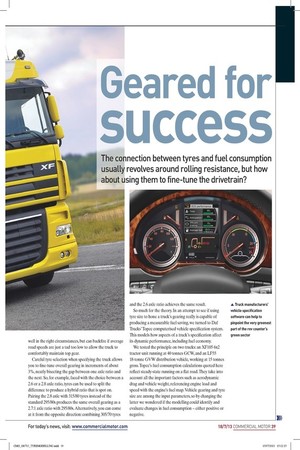Geared for sixcess The connection between tyres and fuel consumption
Page 31

Page 30

If you've noticed an error in this article please click here to report it so we can fix it.
usually revolves around rolling resistance, but how about using them to fine-tune the drivetrain?
We are accustomed to thinking about truck tyres in performance terms such as tread wear, rolling resistance, grip or load capacity, so it is easy to overlook the fact that they are also part of a truck's gearing, just as much as the gearbox or the drive-axle ratio.
It is typical for the range of optional drive-axle ratios offered for a tractor unit to change overall gearing in increments of 5%-8%. The risk is that this might be too coarse an adjustment. Faced with a choice of final drive ratios of, say, 2.6:1 or 2.8:1, it is tempting to go with the longer one to save fuel, only to find that the truck is marginally over-geared. This is particularly likely if you have already cut the road-speed limiter back to 85km/h (52.8mph) or even 80km/h.With engine speed now down to, perhaps, 1,150rpm when cruising on the limiter in top, there is precious little flexibility left and relatively mild gradients will send the automated gearbox diving for 11th. This incurs the fuel penalty of a gearshift and elevates engine speed by about 300rpm (25%).
This risk of over-gearing has increased in the past couple of years, with manufacturers such as Daf, Iveco and Scania all turning to engine down-speeding by offering new long-striding final-drive ratios as part of fuel-economy packages for their tractor units. They work well in the right circumstances, but can backfire if average road speeds are just a tad too low to allow the truck to comfortably maintain top gear.
Careful tyre selection when specifying the truck allows you to fine-tune overall gearing in increments of about 3%, neatly bisecting the gap between one axle ratio and the next. So, for example, faced with the choice between a 2.6 or a 2.8 axle ratio, tyres can be used to split the difference to produce a hybrid ratio that is spot on. Pairing the 2.8 axle with 315/80 tyres instead of the standard 295/80s produces the same overall gearing as a 2.7:1 axle ratio with 295/80s. Alternatively, you can come at it from the opposite direction: combining 305/70 tyres and the 2.6 axle ratio achieves the same result.
So much for the theory. In an attempt to see if using tyre size to hone a truck's gearing really is capable of producing a measurable fuel saving, we turned to Daf Trucks' Topec computerised vehicle specification system. This models how aspects of a truck's specification affect its dynamic performance, including fuel economy.
We tested the principle on two trucks: an XF105 6x2 tractor unit running at 40 tonnes GCVV, and an LF55 18-tonne GVVV distribution vehicle, working at 15 tonnes gross. Topec's fuel consumption calculations quoted here reflect steady-state running on a flat road. They take into account all the important factors such as aerodynamic drag and vehicle weight, referencing engine load and speed with the engine's fuel map. Vehicle gearing and tyre size are among the input parameters, so by changing the latter we wondered if the modelling could identify and evaluate changes in fuel consumption — either positive or negative.








































